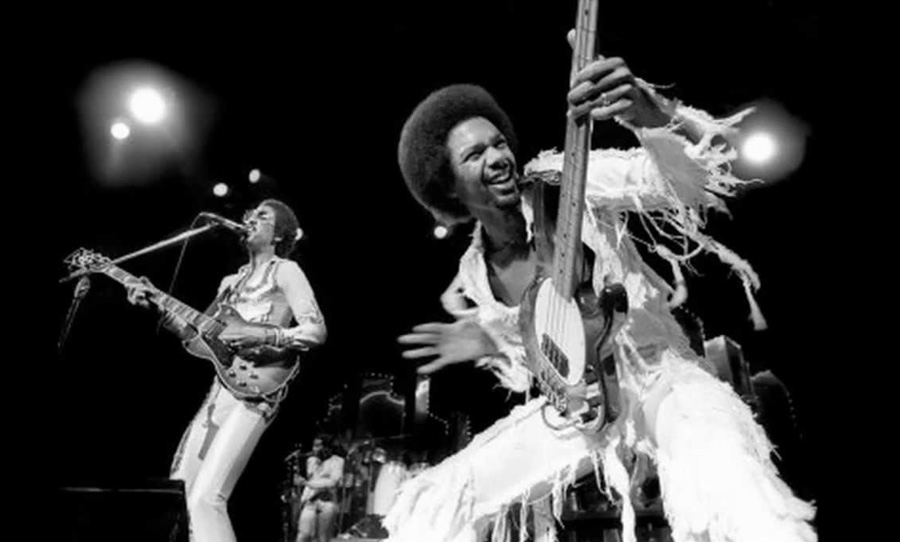Atop the bass family tree sits the two Fender giants: the Precision and the Jazz. It’s fair to say that these two models have spawned more four-string (sometimes five or six too) offspring than any other. It’s also hard to argue that Music Man’s StingRay occupies a branch unto itself, starting its own lineage while maintaining its essential identity.
So how did the StingRay pull splinter off to find its own voice? Through a combination of cutting-edge technology, ergonomic design, dashing good looks and a sound to die for, this iconic bass attracted more than a few high profile purveyors and has continued to steadily grow its fanbase since its inception. 
The Musicman StingRay is the ultimate funk machine. Through a combination of cutting edge technology, a distinct look and fat sound, it became an instant legend.
California Love
Compared with the likes of Fender and Gibson, Music Man was relatively late to the game of crafting instruments. In fact, it was a couple of former Fender employees that began what would become Music Man. Tom Walker and Forrest White left Fender in 1971, unhappy with the direction of the company under the CBS umbrella. After a few early name changes, they settled on the Music Man brand name in 1974.
In a fascinating turn of events, one of their first products was the fruit of a collaboration between Tom Walker and Leo Fender himself – a hybrid solid-state-tube amp, the Sixty-Five. Fender even went on to become the president of the company.
When the company first turned to production of the StingRay, the range also included a guitar – the StingRay 1. While the six-string standard guitar version of the StingRay never became a commercial success, the bass enjoyed a very different reception.
Activated Bass
By the time mid-’70s came, the Fender Precision bass had been in production for around 25 years, the Jazz for around 15. And while there were other famous basses, like Paul McCartney’s Höfner and the Gibson EB-2, these models couldn’t come close to competing with the P and the J. Despite their commercial dominance, the market was well and truly due for a disruption. Enter active electronics.
Companies like Alembic had previously incorporated active electronics into their basses, but none had the capability to execute this engineering on a mass scale like Music Man. So what do we mean by active electronics?
An active electronics circuit incorporates amplification. In the case of the StingRay, this meant that pickup fed a preamp that was built into the body of the bass (powered by a 9-volt battery) giving the user the opportunity to boost the signal in the treble and bass EQ bands.
Ever wonder how it’s possible to pull off those impossibly toppy and aggressive punk tones with a StingRay? Just boost the treble. And that thumping, round bottom end? There’s a bass knob for that.
This key difference makes the StingRay stand in contrast to the Fender basses. Any EQ applied to a P or a J will subtract gain from the circuit. It’s an inherently lossy system, so most of the time, its best to keep all knobs cranked to attain the fullest tone possible from a passive bass.
Finding Fame
Aside from being a breath of fresh air in terms of its electronic innovation, the StingRay landed at just the right time to take advantage of the funk and disco revolution. Dance floors were filling in the late ’70s, driven by the infectious and bubbly bass grooves of The Brothers Johnson, Chic and others.
The StingRay wasn’t just on the funk train though, it picked up its fair share of rock gigs upon its arrival. John Deacon of Queen was known to favour it, as well as Benjamin Orr from The Cars.
Adding to its diverse credentials was its use by the virtuoso Pino Palladino, who used the fretless version of the StingRay in his work alongside Gary Numan. It was also a favourite of arguably the most influential bassist of the last few decades, Flea.
He, along with along other funk-oriented rockers like Rage Against the Machine’s Tim Commerford took advantage of the bass’ ergonomic design, copious space between its single pickup and neck and wide fretboard to turn the instrument into a true slap machine.
Despite being bought out by Ernie Ball in 1985, the Music Man story continues. Ernie Ball’s son, Sterling Ball, is still the CEO and the company has managed to maintain the high standards of craftsmanship that helped them break the Fender bass monopoly more than 40 years ago.
The StingRay itself lives on, coming full circle with a return of the classic, simply titled the StingRay Collection. With the recent release of the American Classic line, the company has demonstrated that it’s not content to relentlessly plumb its own legacy, they’ve instead continued to innovate, paying heed to the lessons that resulted in their initial success.
Though Ernie Ball Music Man continues to make guitars of the six-string variety, it’s their StingRay bass that joins the pantheon of classic modern instruments. The company’s ability to read the musical trends of the era, providing an indestructible tool for the road, as well as a smooth and versatile professional bass for the studio, has ensured that the StingRay’s unmistakable shape and tone won’t soon be forgotten.


